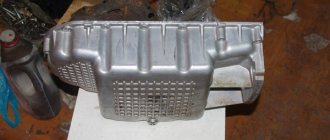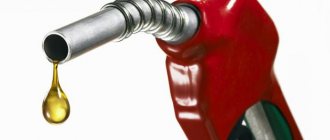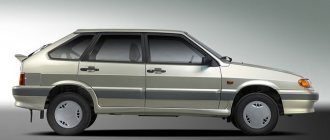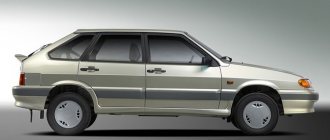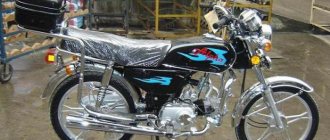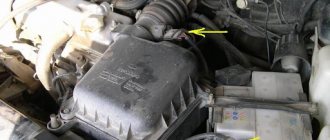Technical data
Content
It differs in all respects from other models with its improved engine system. According to its parameters, which undoubtedly affect gasoline consumption. VAZ 2110 for 100 km with a 1.5 liter engine and having 71 horsepower, it also has a carburetor power system and a 5-speed manual transmission. With such indicators, its maximum speed is 165 km/h, and its acceleration occurs in 14 seconds to 100 km/h.
| Engine | Consumption (highway) | Consumption (city) | Consumption (mixed cycle) |
| 1.5 (72 l. petrol) 5-mech | 5.5 l/100 km | 9.1 l/100 km | 7.6 l/100 km |
| 1.5i (79 hp petrol) 5-mech | 5.3 l/100 km | 8.6 l/100 km | 7.2 l/100 km |
| 1.6 (80 hp petrol) 5-mech | 6 l/100 km | 10 l/100 km | 7.5 l/100 km |
| 1.6i (89 hp, 131 Nm, petrol) 5-mech | 6.3 l/100 km | 10.1 l/100 km | 7.7 l/100 km |
| 1.5i (92 hp, petrol) 5-mech | 7.1 l/100 km | 9.5 l/100 km | 8.1 l/100 km |
Reasons for increased fuel consumption
Using VAZ cars of this type, their owners are often faced with the problem of increasing fuel costs. The main reasons for this unpleasant nuance are the following factors:
:
- breakdowns or malfunctions in engine systems;
- poor quality fuel;
- harsh driving;
- use of additional electrical appliances;
- road structure.
All of the above reasons increase the actual fuel consumption of the VAZ 2110 per 100 km and affect the internal state of the vehicle systems. And if you do not pay attention to these factors, then soon your machine will not be able to fully function.
One of the main reasons can also be attributed to winter driving. Driving during such a period, due to low air temperatures, increases fuel consumption in large quantities due to prolonged warming up of the engine and vehicle interior.
Fuel consumption per 100 km for VAZ 2110
All VAZ 2110 models have similar configurations and the same gasoline consumption. On the highway, fuel consumption per 100 km of the VAZ 2110 is 5.5 liters, with a combined cycle no more than 7.6 liters. But if we compare driving a car within the city, the gasoline consumption per 100 km of a VAZ 2110 will be no more than 9.1 liters. In winter, these figures increase to 2 liters.
But the owners of these cars claim that the real fuel consumption for 100 km is as follows:
- City - up to 12 l.
- The route is up to 8 l.
- Mixed cycle - 9 l.
The manufacturer's table shows fuel consumption figures at idle speed; in reality, they are no different from true gasoline consumption; they amount to approximately 1 liter of liquid fuel.
VAZ-2110 owner reviews
With VAZ-2111 1.5 8 valve engine
- Igor, Kyiv. The car is just right for a family. I bought it in 2008, made in Ukraine. The build quality is the same, quite satisfactory for the money. Now the mileage is 112 thousand, there were breakdowns with the fuel pump and in the gearbox. Everything has already been replaced, and it was relatively inexpensive. In the city, the car consumes 9 liters, with a manual transmission and a 1.5-liter engine.
- Tatyana, Dnepropetrovsk. The car is quite comfortable and dynamic, with a 1.5-liter engine. It seems that under the hood the unit is much more powerful. Excellent smoothness and directional stability. Behavior on the road is all good, but reliability has let us down. I often take my car to a service center; at least the parts are inexpensive. Fuel consumption is 10 liters per hundred.
- Yaroslav, Moscow. I have a 110th Lada with a 1.5-liter 8-valve engine, in the city it consumes up to 10 liters, and on the highway - 8-9 liters. If you don't pick too much, you won't find any equal to this car.
- Anatoly, Lutsk region. I bought a VAZ-2110 in 1999, with an 8-valve 1.5 engine. The engine pleased me with its vigorous acceleration and efficiency. The unit is quite noisy, but this is typical for a budget car. The car behaves well at high speed, especially on a straight line - directional stability is excellent. This is one of the main advantages of the ten, and I also praise it for its more or less spacious interior for five and good finishing materials. Fuel consumption with a one and a half liter engine is 9 liters of gasoline in the city.
- Boris, Sverdlovsk. I'm happy with the car, it's a worthwhile workhorse. Ideal for taxi work. I repainted it yellow and am now getting clients. Now the mileage is 120 thousand km, I service it myself. I always have a set of pelvic guides in the trunk, everything is as it should be. The only negative in the design is the thick stern, perhaps even too thick. Otherwise, I will praise the car for its brutal and austere appearance in the style of the 1980s.
- Oleg, Vologda region. I have a ten since 2005, I use it every day. It rides comfortably and accelerates nicely. Under the hood there is a 1.5-liter 8-valve engine, with which gasoline consumption does not exceed 10 liters per hundred.
- Larisa, Perm. I have a lot in common with this car, first my father used it, then my brother. Then I decided to buy a brand new Volkswagen and sell the ten. And then I showed up. In short, the car became mine, and I will not give it to anyone. I was used to ten, I didn’t even expect it. A very comfortable car. Just right for the city. As for breakdowns, let the service deal with them. I just want the car to drive. Fuel consumption is 10 liters, with a 1.5 petrol engine.
- Nikolay, Donetsk. Lada 110 is a universal car for every day. Equipped with a 1.5-liter engine, although only 8 valves. Fuel consumption in the city is 10 liters. I liked the car, but I advise those who have not driven one not to listen.
- Alexander, Krasnodar region. Ten is my first car, I bought it used, right after graduating from driving school. Comfortable and dynamic, with a peppy 1.5-liter engine. Consumption of 8-10 liters of gasoline per hundred.
With VAZ-21114 1.6 8 valve engine
- Yuri, Dnepropetrovsk. VAZ-2110 is the car of my childhood. I dreamed about it back in the nineties, when I was sitting on the couch and leafing through the magazine Behind the Wheel, my favorite by the way. I grew up a little and bought a used ten. I expected more of course, because in the pictures she looks more beautiful. The car is like a car, I didn’t experience any excitement. I sold it after six months. Dynamic and economical car. With a 1.6 engine it consumes up to 10 liters per hundred.
- Mikhail, Arkhangelsk. I have owned the car since 1999. I bought a new one, for little money back then. Drove 200 thousand km, sold in 2000. By the end there were countless breakdowns. You still have to service it yourself. Fuel consumption with a 1.6-liter engine is 8-10 liters.
- Oleg, St. Petersburg. I have had the car since 2000, currently the mileage is 150 thousand km. I'm happy with the car, comfortable and soft suspension, dynamic 1.6-liter engine. Consumes 10 liters per hundred in the average cycle. The cabin is a bit cramped, especially in width. And overall the car is cramped, with little headroom. It is clear that the developers saved on the interior. Everything is simple and boring, but the car is quite reliable and unpretentious. On the highway it is very economical, about 7-8 liters/100 km. Sometimes I let my wife steer. My son will soon grow up, this will be his first car, so I’m not going to sell it yet.
- Dmitry, Lipetsk. I'm happy with the car, it's a kind of workhorse for all occasions. There is enough space in the cabin for me and my girlfriend. Perhaps we will soon have a new addition, and then we can think about installing a child seat in the back row. In general, the design of the top ten looks very original, strict and brutal. At least our factory workers don’t copy other people’s cars. It’s just that the rear of the car let us down – in my opinion, it’s the fattest car in the world. But nothing can be done, this is a design feature. With a 1.6 engine and manual gearbox, fuel consumption is 10 liters per hundred.
- Alexey, Vorkuta. This sedan is just for me. I'm a handy guy, I'm not afraid of unpredictable repairs. I even somehow got used to it, I used to have a VAZ kopeck, and with it I learned all the delights of life. Ten is more reliable, but also requires careful treatment. With a 1.6 engine it consumes 7-10 liters per 100 km.
- Yulia, Donetsk. A comfortable and high-quality car, 100% optimized for Russian conditions. The brakes are good by the standards of the class, the engine is lively. The car consumes from 8 to 11 liters per hundred.
- Alexander, Sverdlovsk. I liked the car, if you don’t demand much from life. I sat down and drove off, as they say. You shouldn’t expect comfort or any options from the top ten. The car eats acceptable - about 8-9 liters/100 km per 100 km.
- Oleg, Novosibirsk. Lada 110 is my first car. I really wanted a sedan version, so I bought it. Original design, simple and strict. The car perfectly withstands our bumps and potholes; in the city it consumes 9-10 liters per hundred. Under the hood is a 1.6 engine.
- Marina, Yaroslavl. They gave me Lada for my birthday, for good services, so to speak. In general, a dozen were used; some of my relatives were going to sell them, and they decided to give them to me. In good condition, with 70 thousand mileage. Fuel consumption in the city is 8-10 liters/100 km, the 1.6-liter engine works with a manual transmission.
With VAZ-21120 1.5 16 valve engine
- Sergey, Irkutsk. I've had a ten since 2005, now the mileage is 150 thousand km. A car for handy guys, especially when its warranty has expired. I have just such a case. There were breakdowns in the brake system, the fuel pump was replaced. The gearbox was leaking and the clutch disc was covered. In general, a lot can happen over such a mileage, and this must be treated with understanding. Still, this is a technique that tends to become outdated. And I'm not complaining, I knew what I was buying. And if I want a more reliable car, then I’ll buy a more expensive one. For example, now I’m saving up for a Toyota Corolla. As for the top ten, this car both pleased and disappointed me. In general, it eats normally, the 1.6 engine is undemanding when it comes to the quality of gasoline. Consumption 10 liters per 100 km.
- Kirill, Nizhny Novgorod region. The VAZ-2110 is a comfortable car, although it is only noisy in the cabin. But for our roads it is the most suitable option. And the spare parts are cheap. Fuel consumption is 7-9 liters, a 1.6-liter petrol engine with 16 valves per cylinder is installed under the hood
- Anna, Yaroslavl. I'm happy with the car, this is my first car. I just passed my license and ran to the secondary school. The 1.6 engine is powerful and dynamic, consumes an average of 7-8 liters.
- Diana, Arkhangelsk. A great car for the working man. Much better than any Chinese one, even if it has a bunch of options. Reliable and unpretentious. This is how she is, my swallow - ten. With the 1.6 engine it consumes 8 liters of gasoline per hundred.
- Nikolay, Tomsk. I bought a four-door sedan in 2006, the car is worth the money. I needed a car to get around the city. I have been working in a taxi for 25 years, and before that I drove a kopek, a check, and then the Volga appeared. Tens is a bit of a compromise, but it's definitely better than all the buckets of bolts I've had before. With a 1.6 engine and manual transmission, the car consumes 8 - 10 liters in the city.
- Oleg, Nikolaev. Initially I planned to give ten to my wife. She drove it for a month, gave it back - she didn’t like it. The car turned out to be too difficult to drive. I got used to it quickly, of course. In addition, the car seemed too fast and nervous to my wife. It’s just the opposite for me – the dynamics make me happy. With a 16-valve engine, the 1.6 ten eats 8-10 liters per hundred.
With engine VAZ-21124 1.6 16 valves
- Boris, Kaliningrad. My VAZ-2110 is equipped with an engine of slightly less than 100 horses, with a displacement of 1.6. It works decently, just like a manual transmission. So far everything is good, the car has already driven 115 thousand km. So far the car is not encouraging; with a 1.6 engine it consumes an average of 10 liters per hundred.
- Masha, Cheboksary. I'm happy with the car. As for the service, it is handled by people from the Lada brand service; they know a lot about their business. The 1.6 engine and mechanics work wonders - I didn’t expect such agility from them. The car consumes an average of 9-10 liters.
- Svyatoslav, Zaporozhye. It's a good car, I recommend taking it as your first car. But you need to consider your future costs. For example, I installed HBO and I’m not particularly worried. Here they sell such cars now, because they curse everything Russian. They are in fashion. But I’m not going to sell my swallow, it’s like a relic to me. Ten is my first car, with it I have experienced a lot in my life. The car is equipped with a 16-valve engine. With it, fuel consumption in the city reaches up to 11 liters per hundred, which generally suits me. In the suburban cycle, the car consumes about 8 liters per hundred kilometers. Comfortable interior with comfortable seating, economical 1.6-liter engine. Fuel consumption in the urban cycle does not exceed 10 liters/100 km.
- Victor, Vladimir region. A very comfortable car, but the roll in corners is too high. That's why it's comfortable. How come the engineers of our valiant AvtoVAZ could not make an acceptable balance between comfort and behavior on the road. In terms of handling, the top ten is only pleasing on a straight line - in such conditions the car does not yaw from side to side, and confidently holds the road. Moreover, stability increases as speed increases. My sedan is equipped with a 1.6-liter engine, with which fuel consumption reaches 8 liters per hundred.
- Alexey, Kyiv. A car for the whole family, with a pleasant interior trim. I really liked the velor seats, they are warm and cozy. Under the hood everything is the old fashioned way, it’s a 1.6-liter engine with a consumption of 9-10 liters/100 km.
- Dmitry, Petropavlovsk. With such a car you can go anywhere, it’s almost a crossover. With such and such ground clearance. In extreme cases, you can climb up a snowy hill and get out of it, and nothing will happen to you. But you should still have a pelvic guide kit in your trunk, no matter where you are. My ten consumes 10 liters maximum.
Why gasoline consumption may increase
This may be due to the following reasons:
- The gas tank was filled with poor quality fuel;
- The driver drives the car and uses aggressive driving techniques;
- Incorrect engine operation.
In winter, the VAZ 2110’s fuel consumption increases due to the fact that first of all the car needs to be warmed up, including not only its engine, but also the interior of the car.
Each owner of a VAZ 2110 car should carry out technical diagnostics to identify any breakdowns in it. This is especially important to do if it begins to consume more gasoline.
Fuel consumption
One of the important aspects when choosing a particular version of a car is the cost of gasoline. It is important to remember that the fuel consumption of the VAZ 2110, whether it is an injector or a carburetor model, has optimal performance and does not differ from real data. Therefore, when buying a car of this class, there is a high probability that the injection version will be the best and most reliable.
8-valve vases
These car models are equipped with carburetor and injector fuel supply systems. The first version shows these real numbers: the urban cycle is 10-12 liters, the suburban cycle is about 7-8 liters, and the mixed cycle is 9 liters per 100 km
. Fuel consumption rates for a VAZ 2110 (carburetor) in the city do not exceed 9.1 liters, on the highway - 5.5 liters, and in the combined cycle - about 7.6 liters.
According to the data on cars with an injector, the model with a 1.5 liter engine according to the passport has the same figures for fuel costs as the carburetor version. According to information from the owners of this VAZ model, gasoline consumption outside the city is 6-7 liters, in the city about 10 liters, and in mixed driving - 8.5 liters per 100 km.
The 1.6-liter engine consumes 5.5 liters on the highway, 9 liters in urban driving and 7.6 liters in mixed driving.
. Actual data confirms that the average fuel consumption of a VAZ 2110 in the city is 10 liters, country driving “consumes” no more than 6 liters, and in mixed mode about 8 liters per 100 km.
Lada with 16 valves
Such models have their advantages due to a larger number of engine valves and better fuel costs: in the city they do not exceed 8.5 liters, in the combined cycle about 7.2 liters, and on the highway no more than 5 liters. The actual fuel consumption for a 16-valve VAZ 2110 looks like this: city driving “consumes” 9 liters, mixed driving about 7.5 liters, and country driving about 5.5-6 liters. These data apply to models with a 1.5 liter engine.
Regarding the 1.6 engine, its figures have a different form: in the city it consumes about 8.8 liters, outside the city no more than 6 liters, and in the combined cycle - 7.5 liters per 100 km. Actual indicators, accordingly, differ from passport
. Therefore, the gasoline consumption of the VAZ 2110 on the highway is 6-6.5 liters, in the urban cycle - 9 liters, and in the mixed cycle no more than 8 liters.
Reasons for increased consumption
Hyundai ix35 details about fuel consumption
The on-board computer screen shows increased fuel consumption
The increase in engine fuel consumption on the VAZ-2112 is identical to all other engines of any family of cars. But it is worth considering this issue in more detail. So, what are the reasons for the increase in consumption:
- Fuel system malfunction.
- Problems with the injector.
- The fault lies in the catalyst.
- Air filter dirty.
- Engine temperature.
- Sensors and ECU.
Once the reasons have been determined, you can begin step-by-step repairs.
Methods for solving the problem
To eliminate increased fuel consumption, it is worth understanding the design features of not only the main power unit, but also the auxiliary systems on which the operation of the engine as a whole depends. Thus, several systems become the causes at once. But how can we determine where exactly the malfunction occurred? To do this, consider the sequence of diagnostic and repair actions for systems.
Sensors and ECU
Often, errors are hidden here, and you can also see where the problem is hiding. To perform diagnostics, you need to connect via a tablet or laptop to the “brains” of the car using a USB – K-line cable.
Diagnostics through the instrument panel of VAZ-2112
A transcript of the errors that could be seen in the video is given below in the picture.
ECU error codes and their interpretation
The first reason may be accumulated errors in the block itself, where the commands already contradict each other, and the injectors began to supply an increased amount of the fuel mixture. The treatment is simple - resetting errors or installing a new operating system. Many car owners recommend Paulus.
If resetting the ECU errors did not help, then it is worth checking the functionality of the sensors that are responsible for the air-fuel mixture, namely:
- Mass air flow sensor.
- Lambda probe.
- Throttle position sensor.
- Temperature sensor.
Engine control circuit and sensors
It is these sensors that can cause fuel consumption to increase. If diagnostics show that one of them is faulty, it must be replaced. If, however, the consumption remains the same, you need to move on and look for the problem in another unit.
Fuel system
It is in the fuel system that the mystery of increased engine fuel consumption may lie. First of all, you need to check the pressure in the fuel pipes and fuel rail. Several parts that have failed for various reasons can contribute to this effect.
Dirty fuel module mesh
The first two items to check are the fuel pump and the fuel filter. Dismantling the fuel module may be a clue, since the filter mesh could simply be clogged. But the filter is not visible, so you just have to change it. Low-quality fuel, which is saturated in the modern gasoline market, as well as low-quality spare parts can cause this unit to fail ahead of time.
Dirty fuel filter
How to identify electrical problems in a car?
How to install fuel pressure regulator VAZ 2110
The first step is to understand whether your car really has power problems. There are two groups of problems in this regard; roughly, all problems can be divided into problems during startup and strange operation of the electrical network after starting the engine
It is important to distinguish this because different modules are involved in these processes. It’s worth figuring out what symptoms of the car you should look for if the electrical network is not working well after starting the engine:
- the operation of all the lamps in the cabin, as well as the headlights, side lights and brake lights is too dim; this may not be very noticeable, but in reality the difference in brightness is noticeable;
- turning off some elements of the electrical network without permission under fairly heavy loads, for example, when the fan in the cabin is turned on, the music may turn off;
- when revving up at idle, the brightness of the interior lighting noticeably increases for a second, but when other equipment is turned on, the brightness decreases;
- perhaps a barely noticeable or annoying blinking of the light, uneven illumination of the road, rapid failure of light bulbs in various modules of your car;
- a decrease in fan speed is noticeably felt when optics, music or other power consumers are turned on; there may be an incorrect connection in the network.
The problem is that a car owner can easily get used to many such manifestations. And in this case there will be no surprises. You can get used to dim light, poor airflow and other troubles. But in general, this mode of operation is very harmful to your car. Sudden failure of the fuel pump, climate system, poor operation of the automatic transmission and other components is possible.




